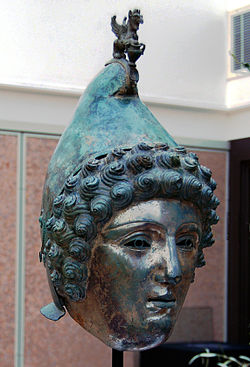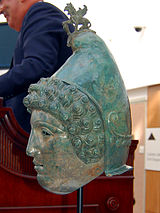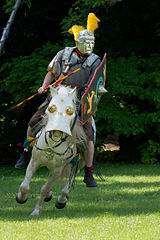- Crosby Garrett Helmet
-
Coordinates: 54°28′44″N 2°25′12″W / 54.479°N 2.420°W
Crosby Garrett Helmet 
The helmet at the saleMaterial Brass Size 407 millimetres (16.0 in) high Created Roman, 1st–3rd century AD Discovered By a metal detectorist in May 2010 Place Crosby Garrett, Cumbria Present location Private possession The Crosby Garrett Helmet is a brass Roman cavalry helmet dating to the late 1st to mid 3rd century AD. It was found by an unnamed metal detectorist near Crosby Garrett in Cumbria, England, in May 2010, close to a Roman road, but a distance from any recorded Roman settlements.[1] The helmet is thought to have been used for ceremonial occasions rather than for combat. Similar helmets found in Britain are the Ribchester Helmet (found in 1796) and the Newstead Helmet (found in 1905), though it has closer parallels with helmets found in southern Europe.[2]
Dr Ralph Jackson, Senior Curator of Romano-British Collections at the British Museum, has described the helmet as "...an immensely interesting and outstandingly important find ... Its face mask is both extremely finely wrought and chillingly striking, but it is as an ensemble that the helmet is so exceptional and, in its specifics, unparalleled. It is a find of the greatest national (and, indeed, international) significance."[3]
On 7 October 2010, the helmet was sold at Christie's for £2.3 million (US$3.6 million) to an undisclosed private buyer. Tullie House Museum and Art Gallery in Carlisle sought to purchase the helmet, with the support of the British Museum but was outbid.[4]
Contents
Description
The Crosby Garrett helmet is an almost complete example of a two-piece Roman cavalry helmet. The visor portrays the face of a youthful, clean-shaven male with curly hair. The headpiece is in the shape of a Phrygian cap, on the crest of which is a winged griffin that stands with one raised foot resting on an amphora. The visor was originally attached to the headpiece via an iron hinge, which has not survived; its existence has been inferred from the presence of powdery deposits of iron residue. The helmet was fastened using a leather strap attached to a decorated rivet between each ear and was well-used. Wear marks caused by its owner opening and closing the visor are still visible, and at some point it had to be repaired using a bronze sheet riveted into place to stabilise two splits.[5] Only two other Roman helmets complete with visors have been found in Britain.[2]
The helmet and visor were cast from an alloy consisting of an average of 82% copper, 10% zinc and 8% tin. This probably represents a low-zinc brass with some tin added to improve the quality of the casting. Some of the fragments show traces of a white metal coating, indicating that the visor would originally have been tinned to give the appearance of silver.[6] The griffin was cast separately from a different alloy consisting of 68% copper, 4% zinc, 18% tin and 10% lead, and was probably cast from scrap metal. The metal has been subject to some leaching during its burial, but when new the visor would have appeared silver and the headpiece would have been a coppery yellow colour.[5]
There has been much debate about the symbolic meaning of the helmet's design. The griffin was the companion of Nemesis, the goddess of vengeance and fate; both were often associated with gladiatorial combat and were symbolic agents of death. The meaning of the face and headpiece are less clearly identifiable. Suggestions have ranged from the Greek god Attis and the hero Perseus, to the Roman gods Mithras and Jupiter Dolichenus, to a more general Eastern Mediterranean appearance that could possibly have been meant to suggest a Trojan identity.[5]
Discovery and restoration
The helmet and visor were found in May 2010 in pastureland on a farm owned by Eric Robinson at Crosby Garrett in Cumbria. The finder, an unnamed metal detectorist in his 20s from Peterlee, County Durham, had been detecting with his father in the field and one adjacent for some years but had previously only found a few small artefacts, including some Roman coins. The findspot is situated not far from a Roman road. A number of earthworks are located nearby, suggesting the presence of a previously unrecorded ancient settlement.[5] There was no known Roman garrison in the immediate vicinity of the discovery, but the area was strategically placed on the route to the northern frontier of Roman Britain, and so there would have been a substantial Roman military presence in the area.[6] It is expected that an archaeological examination of the findspot will be carried out in due course.[7]
The finder discovered the helmet and visor buried together some 25 cm (10 in) below the surface. The helmet was found in 33 large fragments and 34 small fragments and had apparently been folded before burial. The visor was mostly intact and had been placed face down. The griffin had become detached and was found with the helmet. No other artefacts were found. The finder did not initially realise that he had found a Roman artefact and thought at first that it was a Victorian ornament. He eventually realised what it was after searching the internet, and consulting dealers and auction catalogues.[5]
Find Liaison Officers from the Portable Antiquities Scheme were notified of the discovery and visited the findspot along with the finder. Christie's commissioned Darren Bradbury, an independent conservator and restorer, to restore the helmet and visor for sale.[5] Although Christie's was asked to delay the restoration so that a full scientific examination could be carried out, this request was not granted and information about the helmet's burial may have been lost as a result.[7] However, the British Museum was able to inspect the find during restoration and X-ray fluorescence spectrometry was carried out to determine the composition of the headpiece, visor and griffin. Bradbury's restoration work took some 240 hours and involved the repair of cracks and holes using resin and cyanoacrylate, retouched to match the appearance of the surrounding material.[5]
Similarities and usage
The helmet and visor have marked similarities to a number of other Roman cavalry helmets. The visor is a cavalry sports type C (H. Russell Robinson classification) or type V (Maria Kohlert classification). Similar examples have been found across the Roman Empire from Britain to Syria. It is of the same type as the Newstead Helmet, found in Scotland in 1905, and its facial features most closely parallel a helmet that was found at Nola in Italy and is now in the British Museum. The rendering of the hair is similar to that of a type C helmet found at Belgrade in Serbia and dated to the 2nd century AD.[2] The griffin ornament is unique, though it may parallel a lost "sphinx of bronze" that may originally have been attached to the crest of the Ribchester Helmet, discovered in Lancashire in 1796. The headpiece is nearly unique; only one other example in the form of a Phrygian cap has been found, in a fragmentary state, at Ostrov in Romania, dated to the second half of the 2nd century AD. Rings on the back of the helmet and on the griffin may have been used to attach colourful streamers or ribbons.[2]
Such helmets were used for hippika gymnasia, cavalry tournaments that were performed in front of emperors and senior commanders. Horses and riders wore lavishly decorated clothes, armour and plumes while performing feats of horsemanship and re-enacting historical and legendary battles, such as the wars of the Greeks and Trojans.[5] According to the Roman writer Arrian,
[T]hose of high rank or superior in horsemanship wear gilded helmets of iron or bronze to draw the attention of the spectators. Unlike the helmets made for active service, these do not cover the head and cheeks only but are made to fit all round the faces of the riders with apertures for the eyes . . . From the helmets hang yellow plumes, a matter of décor as much as utility. As the horses move forward, the slightest breeze adds to the beauty of these plumes.[8]Unlike combat gear, which belonged to the army and had to be returned, cavalry sports equipment appears to have been commissioned and bought privately by its wearers. It was evidently retained by them after they completed their service. Both helmets and visors have been found in non-military contexts, as well as in and around forts.[5] In some cases they were carefully folded up and buried, as in the case of the Guisborough Helmet. The Dutch historian Johan Nicolay has identified a "lifecycle" for Roman military equipment in which ex-soldiers took certain items home with them as a reminder of their service and occasionally disposed of them away from garrison sites as grave goods or votive offerings.[9]
Auction and controversy
 The helmet on auction at Christie's auction house in London on 7 October 2010
The helmet on auction at Christie's auction house in London on 7 October 2010
Although the find was reported under the Portable Antiquities Scheme, it was not declared treasure under the 1996 Treasure Act because single items of non-precious metal are not covered by the act. The finder and landowner were thus free to dispose of the helmet as they saw fit. The discovery was publicly announced by Christie's in mid-September 2010; the helmet was the centrepiece of its 7 October auction catalogue, featuring on the cover and six more pages. Its value was put at £200,000 – £300,000 ($309,200 – $463,800). The Tullie House Museum and Art Gallery in Carlisle launched an appeal with the aim of purchasing the helmet and making it the focus of a new Roman frontier gallery due to open in 2011. The campaign immediately attracted numerous donations, including £50,000 from an anonymous overseas benefactor who offered the sum if a matching sum could be raised by the public (it was); a £1 million offer from the National Heritage Memorial Fund; a £300,000 pledge from the Headley Trust and the Monument Trust; £200,000 from the Art Fund; and £75,000 from the J Paul Getty Jnr Charitable Trust. By the time of the auction three and a half weeks after the campaign had been launched, the museum had raised enough money to support a bid of up to £1.7 million. Behind the scenes, efforts were made to persuade the finder and landowner to agree a private sale with the museum, but these approaches failed.[5]
The initial estimate was passed within seconds of the auction opening. Six bidders pushed the price towards a million pounds and Tullie House was forced to drop out at £1.7 million. Two remaining bidders took the bid past £2 million; the winning bidder, an anonymous UK resident and fine art collector bidding by phone, paid a total of £2,330,468.75 including the buyer's premium and VAT. The outcome aroused controversy and calls for the Treasure Act to be revised, though British Archaeology noted that its isolated setting may have resulted in the helmet escaping even a revised act.[5] It is still possible that the helmet could come into public ownership; if the winning bidder wishes to export it, an export licence would have to be applied for and if a temporary export bar was placed on it an opportunity could arise for funds to be raised by a public institution to purchase the helmet.[4]
References
- ^ "Treasure hunter finds rare antique in Cumbria". BBC. 13 September 2010. http://www.bbc.co.uk/news/uk-england-cumbria-11287093. Retrieved 2010-09-13.
- ^ a b c d "A Roman Bronze Cavalry Parade Helmet". Christies. September 2010. http://www.christies.com/LotFinder/lot_details.aspx?from=searchresults&intObjectID=5358441&sid=f7bc10b5-59f1-41fd-91f9-5c2b2b53ec7d. Retrieved 2010-03-03.
- ^ Jackson, Ralph (9 September 2010). "Roman Cavalry Sports helmet from Crosby Garrett, Cumbria". http://www.finds.org.uk/documents/file/rjReport.pdf. Retrieved 2010-09-14.
- ^ a b Barnes, Anthony (7 October 2010). "Roman helmet found in field sells for £2.3m". The Independent (London). http://www.independent.co.uk/news/uk/home-news/roman-helmet-found-in-field-sells-for-23m-2100601.html. Retrieved 2010-10-07.
- ^ a b c d e f g h i j k Worrell, Sally; Jackson, Ralph; Mackay, Andrew; Bland, Roger; Pitts, Mike (Jan/Feb 2011). "The Crosby Garrett Roman Helmet". British Archaeology (116). http://www.britarch.ac.uk/ba/ba116/feat1.shtml. Retrieved 2011-03-03.
- ^ a b Worrell, Sally. "LANCUM-E48D73 HELMET". Portable Antiquities Scheme. http://www.finds.org.uk/database/artefacts/record/id/404767. Retrieved 2010-09-13.
- ^ a b Kennedy, Maev (13 September 2010). "Roman cavalry helmet found with metal detector may go abroad at auction". The Guardian (London). http://www.guardian.co.uk/culture/2010/sep/13/roman-helmet-metal-detector-cumbria. Retrieved 2010-09-13.
- ^ Arrian, Ars Tactica 34
- ^ Nicolay, Johan. Armed Batavians: Use and Significance of Weaponry and Horse Gear from Non-military Contexts in the Rhine Delta (50 BC to AD 450). Amsterdam University Press - Amsterdam Archaeological Studies, 2008. ISBN 9789053562536
External links
- Roman Cavalry Sports helmet from Crosby Garrett, Cumbria by Dr Ralph Jackson
- Roman Helmet Appeal
- Christie's sale catalogue
- "Exceptional Roman cavalry helmet discovered in Cumbria". Daniel Pett, Portable Antiquities Scheme, 13 September 2010
Categories:- 2010 archaeological discoveries
- 1st-millennium works
- Ancient Roman helmets
- Archaeological artefacts
- Metal detecting finds in the United Kingdom
- Roman archaeology
- Roman Britain
Wikimedia Foundation. 2010.


